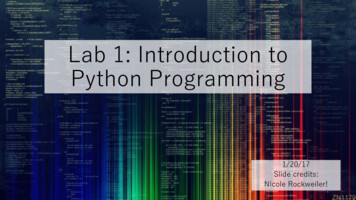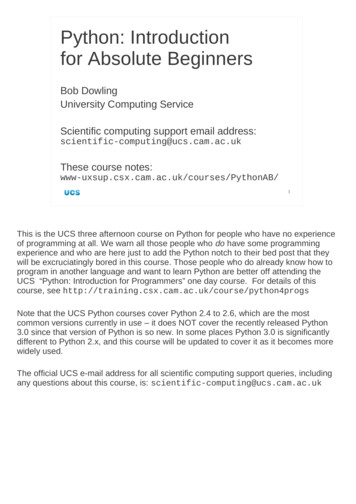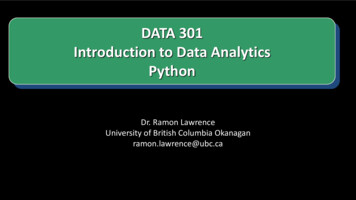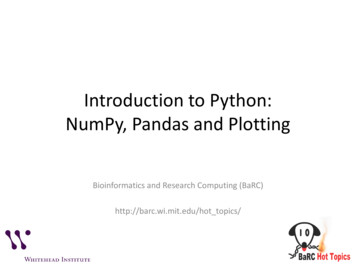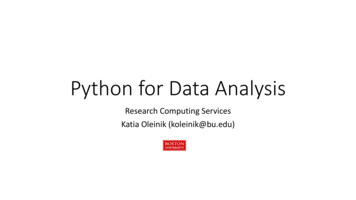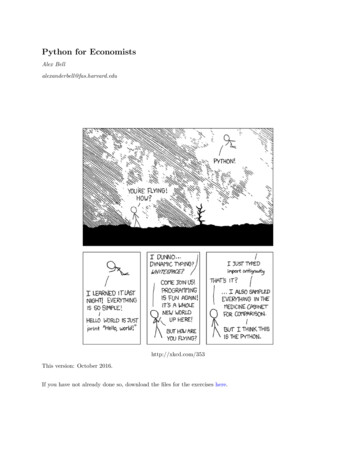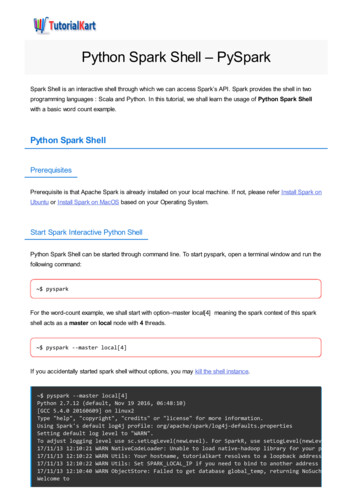
Transcription
Introduction to ProgrammingLanguages and Techniquesxkcd.comFULL PYTHON TUTORIALLast updated 9/1/2014
Full Python Tutorial Developed by Guido van Rossum in the early 1990sNamed after Monty PythonAvailable on eniacAvailable for download from http://www.python.org2
Python Interpreted language: work with an evaluatorfor language expressions (like DrJava, butmore flexible) Dynamically typed: variables do not have apredefined type Rich, built-in collection types: ListsTuplesDictionaries (maps)Sets Concise3
Language features Indentation instead of braces Several sequence types Strings ’ ’: made of characters, immutable Lists [ ]: made of anything, mutable Tuples ( ) : made of anything, immutable Powerful subscripting (slicing) Functions are independent entities (not allfunctions are methods) Exceptions as in Java Simple object system Iterators (like Java) and generators4
Why Python? Good example of scripting language “Pythonic” style is very concise Powerful but unobtrusive object system Every value is an object Powerful collection and iterationabstractions Dynamic typing makes generics easy5
Dynamic typing – the key difference Java: statically typed Variables are declared to refer to objects of a giventype Methods use type signatures to enforce contracts Python Variables come into existence when first assignedto A variable can refer to an object of any type All types are (almost) treated the same way Main drawback: type errors are only caught atruntime6
Recommended Reading On-line Python tutorials The Python Tutorial (http://docs.python.org/tutorial/) Dense but more complete overview of the most important partsof the language See course home page for others PEP 8- Style Guide for Python Code http://www.python.org/dev/peps/pep-0008/ The official style guide to Python, contains many helpfulprogramming tips Many other books and on-line materials If you have a specific question, try Google first7
IMPORTANT! This slide deck is a superset of slides used in lecture. Extra slides have titles in Dark Red. POINTS IN DARK RED ON THE SLIDES WILL ALSOBE SKIPPED IN LECTURE Usually they’re about parts of Python that are very much like Java SO I WON’T TALK ABOUT THIS POINT IN LECTURE The full slide set provides a reasonable manual forPython. LEARN PYTHON BY PLAYING WITH EXAMPLESFROM THE SLIDES & MAKING UP YOUR OWN That Python is interpreted & simple makes this easy.8
Technical IssuesInstalling & Running Python
Which Python? Python 2.7 Current version on Eniac, so we’ll use it Last stable release before version 3 Implements some of the new features in version 3,but fully backwards compatible Python 3 Released a few years agoMany changes (including incompatible changes)Much cleaner language in many waysStrings use Unicode, not ASCIIBut: A few important third party libraries are notyet compatible with Python 3 right now10
The Python Interpreter Interactive interface to Python% pythonPython 2.5 (r25:51908, May 25 2007, 16:14:04)[GCC 4.1.2 20061115 (prerelease) (SUSE Linux)] on linux2Type "help", "copyright", "credits" or "license" for more information. Python interpreter evaluates inputs: 3*(7 2)2711
The IDLE GUI Environment(Windows)12
IDLE Development Environment Shell for interactive evaluation. Text editor with color-coding and smart indentingfor creating Python files. Menu commands for changing system settingsand running files.13
Running Interactively on UNIX(ENIAC)On Unix % python 3 36 Python prompts with ‘ ’. To exit Python (not Idle): In Unix, type CONTROL-D In Windows, type CONTROL-Z Enter 14
Running Programs on UNIX% python filename.pyYou can create python files using emacs.(There’s a special Python editing mode.M-x python-mode)To make a python file executable, make this text thefirst line of the file :#!/usr/bin/python15
The Basics
A Code Sample (in IDLE)x 34 - 23# A comment.y “Hello”# Another one.z 3.45if z 3.45 or y “Hello”:x x 1y y “ World”# String concat.print xprint y17
Enough to Understand the Code Indentation matters to the meaning of the code: Block structure indicated by indentationThe first assignment to a variable creates it. Variable types don’t need to be declared. Python figures out the variable types on its own.Assignment uses and comparison uses .For numbers - * / % are as expected. Special use of for string concatenation. Special use of % for string formatting (as with printf in C)Logical operators are words (and, or, not)not symbolsSimple printing can be done with print.18
Basic Datatypes Integers (default for numbers)z 5 / 2# Answer is 2, integer division. Floatsx 3.456 Strings Can use “” or ‘’ to specify.“abc” ‘abc’ (Same thing.) Unmatched can occur within the string.“matt’s” Use triple double-quotes for multi-line strings or strings thancontain both ‘ and “ inside of them:“““a‘b“c”””19
WhitespaceWhitespace is meaningful in Python: especiallyindentation and placement of newlines. Use a newline to end a line of code. Use \ when must go to next line prematurely. No braces {to mark blocks of code in Python Use consistent indentation instead.} The first line with less indentation is outside of the block. The first line with more indentation starts a nested block Often a colon appears at the start of a new block.(E.g. for function and class definitions.)20
Comments Start comments with # – the rest of line is ignored. Can include a “documentation string” as the first line of anynew function or class that you define. The development environment, debugger, and other toolsuse it: it’s good style to include one.def my function(x, y):“““This is the docstring. Thisfunction does blah blah blah.”””# The code would go here.21
Assignment Binding a variable in Python means setting aname to hold a reference to some object. Assignment creates references, not copies (like Java) A variable is created the first time it appears onthe left side of an assignment expression:x 3 An object is deleted (by the garbage collector)once it becomes unreachable. Names in Python do not have an intrinsic type.Objects have types. Python determines the type of the reference automaticallybased on what data is assigned to it.22
(Multiple Assignment) You can also assign to multiple names at the same time. x, y 2, 3 x2 y323
Naming Rules Names are case sensitive and cannot start with a number.They can contain letters, numbers, and underscores.bobBobbob2 bobbob 2BoB There are some reserved words:and, assert, break, class, continue, def, del,elif, else, except, exec, finally, for, from,global, if, import, in, is, lambda, not, or, pass,print, raise, return, try, while24
Sequence types:Tuples, Lists, and Strings
Sequence Types1. Tuple A simple immutable ordered sequence of items Immutable: a tuple cannot be modified once created.Items can be of mixed types, including collection types2. Strings Immutable Conceptually very much like a tuple Regular strings use 8-bit characters. Unicodestrings use 2-byte characters. (All this is changedin Python 3.)3. List Mutable ordered sequence of items of mixed types26
Sequence Types 2 The three sequence types (tuples, strings, and lists) sharemuch of the same syntax and functionality. Tuples are defined using parentheses (and commas). tu (23, ‘abc’, 4.56, (2,3), ‘def’) Lists are defined using square brackets (and commas). li [“abc”, 34, 4.34, 23] Strings are defined using quotes (“, ‘, or “““). st st ststring “Hello World” ‘Hello World’ “““This is a multi-linethat uses triple quotes.”””27
Sequence Types 3 We can access individual members of a tuple, list, or stringusing square bracket “array” notation. Note that all are 0 based tu (23, ‘abc’, 4.56, (2,3), ‘def’) tu[1]# Second item in the tuple.‘abc’ li [“abc”, 34, 4.34, 23] li[1]# Second item in the list.34 st “Hello World” st[1]# Second character in string.‘e’28
Negative indices t (23, ‘abc’, 4.56, (2,3), ‘def’)Positive index: count from the left, starting with 0. t[1]‘abc’Negative lookup: count from right, starting with –1. t[-3]4.5629
Slicing: Return Copy of a Subset 1 t (23, ‘abc’, 4.56, (2,3), ‘def’)Return a copy of the container with a subset of the originalmembers. Start copying at the first index, and stop copyingbefore the second index. t[1:4](‘abc’, 4.56, (2,3))You can also use negative indices when slicing. t[1:-1](‘abc’, 4.56, (2,3))Optional argument allows selection of every nth item. t[1:-1:2](‘abc’, (2,3))30
Slicing: Return Copy of a Subset 2 t (23, ‘abc’, 4.56, (2,3), ‘def’)Omit the first index to make a copy starting from the beginningof the container. t[:2](23, ‘abc’)Omit the second index to make a copy starting at the firstindex and going to the end of the container. t[2:](4.56, (2,3), ‘def’)31
Copying the Whole SequenceTo make a copy of an entire sequence, you can use [:]. t[:](23, ‘abc’, 4.56, (2,3), ‘def’)Note the difference between these two lines for mutablesequences: list2 list1# 2 names refer to 1 ref# Changing one affects both list2 list1[:] # Two independent copies, two refs32
The ‘in’ Operator Boolean test whether a value is inside a collection (oftencalled a container in Python: t 3False 4True 4False [1, 2, 4, 5]in tin tnot in t For strings, tests for substrings a 'abcde' 'c' in aTrue 'cd' in aTrue 'ac' in aFalse Be careful: the in keyword is also used in the syntax offor loops and list comprehensions.33
The Operator The operator produces a new tuple, list, or string whosevalue is the concatenation of its arguments. Extends concatenation from strings to other types (1, 2, 3) (4, 5, 6)(1, 2, 3, 4, 5, 6) [1, 2, 3] [4, 5, 6][1, 2, 3, 4, 5, 6] “Hello” “ ” “World”‘Hello World’34
Mutability:Tuples vs. Lists
Lists: Mutable li [‘abc’, 23, 4.34, 23] li[1] 45 li[‘abc’, 45, 4.34, 23] We can change lists in place. Name li still points to the same memory reference whenwe’re done.36
Tuples: Immutable t (23, ‘abc’, 4.56, (2,3), ‘def’) t[2] 3.14Traceback (most recent call last):File " pyshell#75 ", line 1, in -topleveltu[2] 3.14TypeError: object doesn't support item assignmentYou can’t change a tuple.You can make a fresh tuple and assign its reference to a previouslyused name. t (23, ‘abc’, 3.14, (2,3), ‘def’) The immutability of tuples means they’re faster than lists.37
Operations on Lists Only 1 li [1, 11, 3, 4, 5] li.append(‘a’) # Note the method syntax li[1, 11, 3, 4, 5, ‘a’] li.insert(2, ‘i’) li[1, 11, ‘i’, 3, 4, 5, ‘a’]38
The extend method vs the operator. creates a fresh list (with a new memory reference)extend is just like add in Java; it operates on list li in place. li.extend([9, 8, 7]) li[1, 2, ‘i’, 3, 4, 5, ‘a’, 9, 8, 7]Confusing: extend takes a list as an argument unlike Java append takes a singleton as an argument. li.append([10, 11, 12]) li[1, 2, ‘i’, 3, 4, 5, ‘a’, 9, 8, 7, [10, 11, 12]]39
Operations on Lists Only 3 li [‘a’, ‘b’, ‘c’, ‘b’] li.index(‘b’)1*more# index of first occurrence *complex forms exist li.count(‘b’)2# number of occurrences li.remove(‘b’) li[‘a’, ‘c’, ‘b’]# remove first occurrence40
Operations on Lists Only 4 li [5, 2, 6, 8] li.reverse() li[8, 6, 2, 5]# reverse the list *in place* li.sort() li[2, 5, 6, 8]# sort the list *in place* li.sort(some function)# sort in place using user-defined comparison41
Tuples vs. Lists Lists slower but more powerful than tuples. Lists can be modified, and they have lots of handy operations wecan perform on them. Tuples are immutable and have fewer features. To convert between tuples and lists use the list() and tuple()functions:li list(tu)tu tuple(li)42
Dictionaries: a mapping collection type
Dictionaries: Like maps in Java Dictionaries store a mapping between a set of keysand a set of values. Keys can be any immutable type. Values can be any type Values and keys can be of different types in a single dictionary You can definemodifyviewlookupdeletethe key-value pairs in the dictionary.44
Creating and accessingdictionaries d {‘user’:‘bozo’, ‘pswd’:1234} d[‘user’]‘bozo’ d[‘pswd’]1234 d[‘bozo’]Traceback (innermost last):File ‘ interactive input ’ line 1, in ?KeyError: bozo45
Updating Dictionaries d {‘user’:‘bozo’, ‘pswd’:1234} d[‘user’] ‘clown’ d{‘user’:‘clown’, ‘pswd’:1234} Keys must be unique.Assigning to an existing key replaces its value. d[‘id’] 45 d{‘user’:‘clown’, ‘id’:45, ‘pswd’:1234} Dictionaries are unordered New entry might appear anywhere in the output.(Dictionaries work by hashing)46
Removing dictionary entries d {‘user’:‘bozo’, ‘p’:1234, ‘i’:34} del d[‘user’]# Remove one. Note that del is# a function. d{‘p’:1234, ‘i’:34} d.clear() d{} a [1,2] del a[1] a[1]# Remove all.# (del also works on lists)47
Useful Accessor Methods d {‘user’:‘bozo’, ‘p’:1234, ‘i’:34} d.keys()[‘user’, ‘p’, ‘i’]# List of current keys d.values()[‘bozo’, 1234, 34]# List of current values. d.items()# List of item tuples.[(‘user’,‘bozo’), (‘p’,1234), (‘i’,34)]48
Boolean Expressions
True and False True and False are constants Other values are treated as equivalent to eitherTrue or False when used in conditionals: False: zero, None, empty containers True: non-zero numbers, non-empty objects See PEP 8 for the most Pythonic ways to compare Comparison operators: , ! , , , etc. X Y X and Y have same value (like Java equals method) X is Y : X and Y refer to the exact same object (like Java )50
Logical Operators You can also combine Boolean expressions. True if a is True and b is True: True if a is True or b is True: True if a is False:a and ba or bnot a51
Conditional Expressions x true value if condition else false value lazy evaluation: First, condition is evaluated If True, true value is evaluated and returned If False, false value is evaluated and returned52
Control Flow
if Statements (as expected)if x 3:print "X equals 3."elif x 2:print "X equals 2."else:print "X equals something else."print "This is outside the ‘if’."Note: Use of indentation for blocks Colon (:) after boolean expression54
while Loops (as expected) x 3 while x 5:print x, "still in the loop"x x 13 still in the loop4 still in the loop x 6 while x 5:print x, "still in the loop" 55
break and continue You can use the keyword break inside a loop toleave the while loop entirely. You can use the keyword continue inside a loopto stop processing the current iteration of theloop and immediately go on to the next one.56
assert An assert statement will check to make sure thatsomething is true during the course of a program. If the condition if false, the program stops (more accurately: throws an exception)assert(number of players 5) Also found in Java; we just didn’t mention it!57
For Loops
For Loops 1 For-each is Python’s only form of for loop A for loop steps through each of the items in a collectiontype, or any other type of object which is “iterable”for item in collection : statements If collection is a list or a tuple, then the loop stepsthrough each element of the sequence. If collection is a string, then the loop steps through eachcharacter of the string.for someChar in “Hello World”:print someChar59
For Loops 2for item in collection : statements item can be more complex than a singlevariable name. If the elements of collection are themselves collections,then item can match the structure of the elements. (Wesaw something similar with list comprehensions and withordinary assignments.)for (x, y) in [(a,1), (b,2), (c,3), (d,4)]:print x60
For loops and the range() function We often want to write a loop where the variables rangesover some sequence of numbers. The range() functionreturns a list of numbers from 0 up to but not including thenumber we pass to it. range(5) returns [0,1,2,3,4] So we can say:for x in range(5):print x (There are several other forms of range() that providevariants of this functionality ) xrange() returns an iterator that provides the samefunctionality more efficiently61
Abuse of the range() function Don't use range() to iterate over a sequence solely to havethe index and elements available at the same time Avoid:for i in range(len(mylist)):print i, mylist[i] Instead:for (i, item) in enumerate(mylist):print i, item This is an example of an anti-pattern in Python For more, see: http://www.seas.upenn.edu/ lignos/py antipatterns.html pecific-antipatterns-and-badpractices62
Generating Lists using“List Comprehensions”
List Comprehensions 1 A powerful feature of the Python language. Generate a new list by applying a function to every memberof an original list. Python programmers use list comprehensions extensively.You’ll see many of them in real code.[ expression for name in list ]64
[ expression for name in list ]List Comprehensions 2 li [3, 6, 2, 7] [elem*2 for elem in li][6, 12, 4, 14][ expression for name in list ] Where expression is some calculation or operationacting upon the variable name. For each member of the list, the list comprehension1. sets name equal to that member, and2. calculates a new value using expression, It then collects these new values into a list which is thereturn value of the list comprehension.65
[ expression for name in list ]List Comprehensions 3 If the elements of list are other collections, thenname can be replaced by a collection of namesthat match the “shape” of the list members. li [(‘a’, 1), (‘b’, 2), (‘c’, 7)] [ n * 3 for (x, n) in li][3, 6, 21]66
[ expression for name in list if filter]Filtered List Comprehension 1 Filter determines whether expression is performedon each member of the list. When processing each element of list, first check ifit satisfies the filter condition. If the filter condition returns False, that element isomitted from the list before the list comprehensionis evaluated.67
[ expression for name in list if filter]Filtered List Comprehension 2 li [3, 6, 2, 7, 1, 9] [elem * 2 for elem in li if elem 4][12, 14, 18] Only 6, 7, and 9 satisfy the filter condition. So, only 12, 14, and 18 are produced.68
Nested List Comprehensions Since list comprehensions take a list as input andproduce a list as output, they are easily nested: li [3, 2, 4, 1] [elem*2 for elem in[item 1 for item in li] ][8, 6, 10, 4] The inner comprehension produces: [4, 3, 5, 2]. So, the outer one produces: [8, 6, 10, 4].69
For Loops / List Comprehensions Python’s list comprehensions provide a naturalidiom that usually requires a for-loop in otherprogramming languages. As a result, Python code uses many fewer for-loops Caveat! The keywords for and in also appear in thesyntax of list comprehensions, but this is a totallydifferent construction.70
Functions in Python(Methods later)
Defining FunctionsFunction definition begins with defFunction name and its arguments.def get final answer(filename):"""Documentation String"""line1line2return total counter.First line with lessindentation is considered to beoutside of the function definition.Colon.‘return’ indicates thevalue to be sent back to the caller.No declaration of types of arguments or result72
Calling a Function def myfun(x, y):return x * y myfun(3, 4)1273
Functions without returns All functions in Python have a return value even if no return line inside the code. Functions without a return return the special valueNone. None is a special constant in the language.None is used like null in Java.None is also logically equivalent to False.The interpreter doesn’t print None74
Function overloading? No. There is no function overloading in Python. Unlike Java, a Python function is specified by its name alone The number, order, names, or types of its arguments cannot beused to distinguish between two functions with the same name. Two different functions can’t have the same name, even if theyhave different numbers of arguments. But operator overloading – overloading , , -, etc. – is possibleusing special methods on various classes (see later slides)75
Functions are first-class objects in Python Functions can be used just like any other data They can be Arguments to functionReturn values of functionsAssigned to variablesParts of tuples, lists, etc def myfun(x):return x*3 def apply(q, x):return q(x) apply(myfun, 7)2176
Lambda Notation like anonymousinner classes in JavaFunctions can be defined without giving them names.This is most useful when passing a short function as anargument to another function. apply(lambda z: z * 4, 7)28 The first argument to apply() is an unnamed function thattakes one input and returns the input multiplied by four.Note: only single-expression functions can be definedusing this lambda notation.Lambda notation has a rich history in CS research and thedesign of many current programming languages.77
Default Values for Arguments You can provide default values for a function’s arguments These arguments are optional when the function is called def myfun(b, c 3, d “hello”):return b c myfun(5,3,”hello”) myfun(5,3) myfun(5)All of the above function calls return 8.78
Keyword Arguments Functions can be called with arguments out of order These arguments are specified in the call Keyword arguments can be used for a final subset ofthe arguments. def myfun (a, b, c):return a-b myfun(2, 1, 43)1 myfun(c 43, b 1, a 2)1 myfun(2, c 43, b 1)179
Inheritance
Subclasses A class can extend the definition of another class Allows use (or extension ) of methods and attributes alreadydefined in the previous one. New class: subclass. Original: parent, ancestor or superclass To define a subclass, put the name of thesuperclass in parentheses after the subclass’sname on the first line of the definition. class ai student(student): Python has no ‘extends’ keyword like Java. Multiple inheritance is supported.81
Redefining Methods Very similar to over-riding methods in Java To redefine a method of the parent class, include a newdefinition using the same name in the subclass. The old code won’t get executed. To execute the method in the parent class in addition tonew code for some method, explicitly call the parent’sversion of the method.parentClass.methodName(self, a, b, c) The only time you ever explicitly pass ‘self’ as an argument is whencalling a method of an ancestor.82
Extending init Very similar to Java Commonly, the ancestor’s init method isexecuted in addition to new commands. Must be done explicitly You’ll often see something like this in the initmethod of subclasses:parentClass. init (self, x, y)where parentClass is the name of the parent’s class.83
Private Data and Methods Any attribute or method with two leading underscores in itsname (but none at the end) is private. It cannot beaccessed outside of that class. Note:Names with two underscores at the beginning and the end are forbuilt-in methods or attributes for the class Note:There is no ‘protected’ status in Python; so, subclasses would beunable to access these private data either84
Importing and Modules
Import and Modules Programs will often use classes & functions defined inanother file A Python module is a single file with the same name (plusthe .py extension) Modules can contain many classes and functions Access using import (like Java)Where does Python look for module files? The list of directories where Python looks: sys.path When Python starts up, this variable is initialized from thePYTHONPATH environment variable To add a directory of your own to this list, append it to thislist.sys.path.append(‘/my/new/path’) Oops! Operating system dependent .86
Import Iimport somefile Everything in somefile.py can be referred to Function(34) from somefile import * Everything in somefile.py can be referred to by:className.method(“abc”)myFunction(34) Careful! This can overwrite the definition of an existingfunction or variable!87
Import IIfrom somefile import className Only the item className in somefile.py gets imported. Refer to it without a module prefix. Caveat! This can overwrite an existing definition.className.method(“abc”) This was importedmyFunction(34) Not this one88
Commonly Used Modules Some useful modules, included withPython: Module: sys Module: os Module: os.path- Lots of handy stuff.- OS specific code.- Directory processing. The Python standard library has lots ofother useful stuff.89
More Commonly Used Modules Module: math- Mathematical functions. Exponents sqrt Module: Random - Random numbers Randrange(good for simulations, games, ) Uniform Choice Shuffle To see what’s in the standard library of modules, checkout the Python Library Reference: http://docs.python.org/lib/lib.html90
String Operations
String Operations The string class provides a number ofmethods for useful formatting operations: “hello”.upper()‘HELLO’ Check the Python documentation formany other handy string operations. Helpful hint: use string .strip() tostrip off final newlines from lines readfrom files92
String Formatting Operator: % The operator % allows strings to be built out of many dataitems in a “fill in the blanks” fashion. Allows control of how the final string output will appear. For example, we could force a number to display with aspecific number of digits after the decimal point. Very similar to the sprintf command of C. x “abc” y 34 “%s xyz %d” % (x, y)‘abc xyz 34’ The tuple following the % operator is used to fill in theblanks in the original string marked with %s or %d. Check Python documentation for details.93
Printing with Python print a string to the standard output stream using “print” Using the % string operator in combination with the printcommand, we can format our output text. print “%s xyz %d”abc xyz 34%(“abc”, 34)“Print” automatically adds a newline to the end of the string. If youinclude a list of strings, it will concatenate them with a spacebetween them. print “abc”abc Useful trick: print “abc”, “def”abc def print “abc”,doesn’t add newline(does add space)94
String to List to String Join turns a list of strings into one string. separator string .join( some list ) “;”.join( [“abc”, “def”, “ghi”] )“abc;def;ghi” Split turns one string into a list of strings. some string .split( separator string ) “abc;def;ghi”.split( “;” )[“abc”, “def”, “ghi”]95
Convert Anything to a String The built-in str() function can convert an instanceof any data type into a string. You can define how this function behaves for user-createddata types. You can also redefine the behavior of thisfunction for many types. “Hello ” str(2)“Hello 2”96
Special Built-InMethods and Attributes
Built-In Members of Classes Classes contain many methods and attributes that areincluded by Python even if you don’t define them explicitly. Most of these methods define automatic functionality triggered byspecial operators or usage of that class. The built-in attributes define information that must be stored for allclasses. All built-in members have double underscores around theirnames: doc98
Special Methods For example, the method repr exists for all classes,and you can always redefine it. The definition of this method specifies how to turn aninstance of the class into a string. print f sometimes calls f. repr () to produce a string forobject f. If you type f at the prompt and hit ENTER, then you are alsocalling repr to determine what to display to the user asoutput.99
Special Methods – Exampleclass student:.def repr (self):return “I’m named ” self.full name. f student(“Bob Smith”, 23) print fI’m named Bob Smith f“I’m named Bob Smith”100
Special Methods Used to implement operator overloading Most operators trigger a special method, dependent on classinit : The constructor for the class.len : Define how len( obj ) works.copy : Define how to copy a class.cmp : Define how works for class.add : Define how works for classneg : Define how unary negation works for class Other built-in methods allow you to give a class theability to use [ ] notation like an array or ( ) notationlike a function call.101
Special Data Attributes These attributes exist for all classes.doc : Variable storing the documentation string for thatclass.class: Variable which gives you a reference to theclass from any instance of it.module: Variable which gives you a reference to themodule in which the particular class is defined.dict:The dictionary that is actually the namespacefor a class (but not its superclasses). Useful: dir(x) returns a list of all methods and attributes definedfor object x102
Special Data Items – Example f student(“Bob Smith”, 23) print f. docA class representing a student. f. class class studentClass at 010B4C6 g f. class (“Tom Jones”, 34)103
File Processing, Error Handling
File Processing with PythonAbout what you’d expect .fileptr open(“filename”)somestring fileptr.read()for line in fileptr:print linefileptr.close()105
Exception Handling Exceptions are Python objects More specific kinds of errors are subclasses of the gene
Sep 01, 2014 · 6 Dynamic typing –the key difference Java: statically typed Variables are declared to refer to objects of a given type Methods use type signatures to enforce contracts Python Variables come into existence when first assigned to A variable can refer to an object of any type All types are (almost) treated the same way Main drawback: type errors are only caught at




